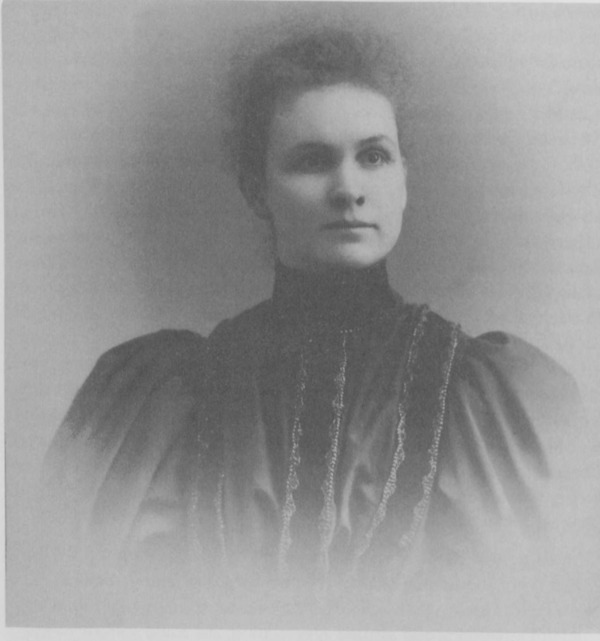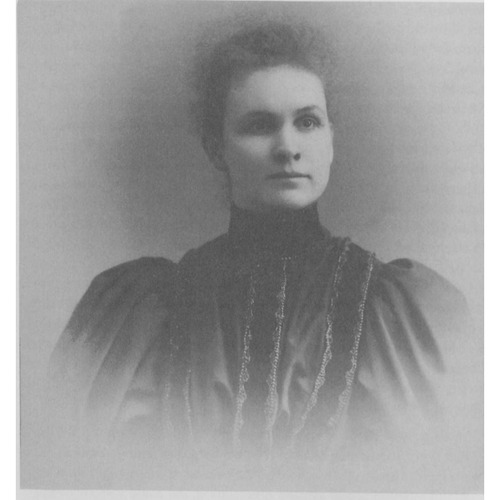
Source: Link
DOW, JEAN ISABELLE (baptized Jane Isabella), medical missionary; b. 25 June 1870 near Fergus, Ont., fifth of the eight children of Peter Dow and Agnes Wilson; d. unmarried 16 Jan. 1927 in Peking (Beijing, People’s Republic of China), and was buried in Changte (Anyang).
Jean Dow is representative of the first generation of Canadian women doctors who chose a missionary career. A granddaughter of Scottish immigrants, she grew up in a progressive “farm home of the best type” with a large library. The Dows were members of the very mission-minded Melville Presbyterian Church in Fergus and it was in this atmosphere that Jeannie, as she was known, felt called to foreign-mission work. A winsome, beautiful girl, she was inordinately shy and quite brilliant. She graduated from primary school at age 10 and high school at 13, and was a teacher by 15. After attending model school in Mount Forest, in 1891 she applied to the Presbyterian Woman’s Foreign Missionary Society, intending to enter Woman’s Medical College in Toronto. She received her mb from Trinity College in 1895 and on 30 September of that year was appointed to succeed the late Dr Lucinda Graham in North Honan (Henan), China.
The Presbyterian mission there had been founded in 1888 by Jonathan and Rosalind Goforth and others, but they had been unable to gain a foothold in the province because of anti-foreign attitudes. Eventually, in 1894, they managed to lease a house in Chuwang, a “wretched” town inside the border. By the time Dow arrived, they had been forced out, but the station was soon re-established.
Studying Chinese gave Dow new freedom – “loosening my English tongue” she called the experience. She learned the colloquialisms of illiterate women and the Chinese equivalents of medical terminology. “Medicine was her profession,” in the words of one biographer, “Evangelism was her passion.” She was always surrounded by women, “gossiping the gospel” as she asked about their families. “Day by day they come in ceaseless procession to the dispensary,” she wrote. In 1897 she opened the first women’s hospital in Honan – a mud-brick ward and chapel-dispensary, which treated 400 patients in its first month. The Boxer rebellion of 1900 forced a harrowing evacuation to the coast, with the missionaries being mobbed and beaten. Dow then went on furlough, during which she studied tropical medicine in New York City, “to get rid of the rust” according to mission historian Margaret H. Brown.
Jean Dow returned in April 1902 and “dwelt among the ruins” in Chuwang while making extensive evangelistic tours. When the Chuwang station was closed she moved to Changte, a major city, where she opened a women’s hospital. As the only practising female physician in North Honan for 20 years – other, married women doctors did not practise – she was at the centre of a controversy over separate facilities for women. Governed by an all-male presbytery, the North Honan mission considered separate wards “useless and unnecessary.” Dow got around the opposition unobtrusively; in 1904 and again in 1913, when a new men’s hospital was constructed, she adapted the old buildings as women’s wards.
Dow’s practice had grown from simple surgery for such problems as cataracts and wolf bites to complicated obstetric treatments and X-rays. Her foremost achievement, with Dr William McClure, was her work on the microbe causing kala-azar, the sandfly-transmitted disease that decimated the children of north China. During the famine of 1920–21 she was credited with saving 400 expectant mothers and children. For her heroic services the Chinese government gave her a medal. She was held in the “highest esteem” too by her mission, as much for her physical and spiritual beauty and strong “womanhood” as for her medical skill.
Despite her fluency in Chinese, her natural reticence hindered her relations with colleagues. Here she was helped over a 30-year period by her “beautiful friendship, based on mutual love,” with another Scots missionary from Wellington County, a nurse named Margaret I. McIntosh. Because Dow was “never articulate in public” (so Margaret Brown recalled), in discussions of her work she would whisper responses to Margaret, who would repeat them aloud. When women were admitted to the mission’s executive committee, Dow was one of the two female members, a role she filled with common sense for several years. In the 1920s her drive for facilities for women was challenged by a new generation of professionals, men and women, who argued for integration on the ground that separate realms led to substandard facilities. The mission, however, deferred to Dow and Dr Isabelle MacTavish, allowing them to build the only women’s hospital in North Honan.
Jean Dow went on furlough at the beginning of civil unrest in 1925. A few months earlier the mission had voted unanimously to join the United Church of Canada. She returned to China in October 1926 in time to open the hospital she had worked for. She was there only two months before she succumbed to an internal complaint and was taken to the Peking Union Medical Hospital, where she died, worn out at 56. Her body was buried in the mission cemetery at Changte.
If Dow had stayed in Canada, she might never have “loosened” her tongue or built a hospital. As one colleague said at her memorial service, being a pioneer worker “she was at liberty to set up her own ideals of personal worth and work, and did set these very high. . . . She touched multitudes of lives for good.” According to recollections compiled in the 1980s, the women of Honan who remembered her agreed.
AO, RG 80-2-0-12, no.19270. LAC, RG 31, C1, Nichol Township, Ont., 1871, div.1: 58; 1881: 13 (mfm. at AO). UCC-C, Biog. file; Fonds 127, 79.205C, boxes 5–9; Photographs. UTA, A1973-0026/87, files for J. I. Dow (53), her brother the Reverend James A. Dow (52), her cousin Dr James Dow (51), and other relatives. Daily Mail and Empire, 18 Jan. 1927. Evening Telegram (Toronto), 18 Jan. 1927. Globe, 18, 22 Jan., 8 Feb. 1927. New Outlook (Toronto), 9 March, 27 April 1927. A. J. Austin, Saving China: Canadian missionaries in the Middle Kingdom, 1888–1959 (Toronto, 1986). D. McD. Beattie, Pillars and patches along the highway: a history of Nichol Township ([Elora, Ont., 1984]). M. H. Brown, “History of the Honan (North China) missions of the United Church of Canada, originally a mission of the Presbyterian Church in Canada, 1887–1951” (4v., typescript, n.p., [1970]; copy in UCC-C). Ruth Compton Brouwer, New women for God: Canadian Presbyterian women and India missions, 1876–1914 (Toronto, 1990). [M. R. Griffith], Jean Dow, m.d.: a beloved physician (Toronto, [193-?]). Carlotta Hacker, The indomitable lady doctors (Toronto, 1974). Presbyterian Record (Montreal), 1895–1926. Hugh Templin and J. M. Imlah, Melville Church, Fergus: a history of the congregation from 1845 to 1945 (Fergus, Ont., 1945).
Cite This Article
Alvyn J. Austin, “DOW, JEAN ISABELLE (baptized Jane Isabella),” in Dictionary of Canadian Biography, vol. 15, University of Toronto/Université Laval, 2003–, accessed April 25, 2025, https://www.biographi.ca/en/bio/dow_jean_isabelle_15E.html.
The citation above shows the format for footnotes and endnotes according to the Chicago manual of style (16th edition). Information to be used in other citation formats:
| Permalink: | https://www.biographi.ca/en/bio/dow_jean_isabelle_15E.html |
| Author of Article: | Alvyn J. Austin |
| Title of Article: | DOW, JEAN ISABELLE (baptized Jane Isabella) |
| Publication Name: | Dictionary of Canadian Biography, vol. 15 |
| Publisher: | University of Toronto/Université Laval |
| Year of revision: | 2005 |
| Access Date: | April 25, 2025 |



